#MarineScience - A UCC-led group of scientists from across the globe have revealed a submarine canyon on the edge of Ireland’s continental shelf, 320km west of Dingle, after mapping an area twice the size of Malta.
The group returned last Friday (10 August) after a research expedition on board the Marine Institute’s RV Celtic Explorer with ROV Holland I, mapping 1,800 sqkm of seabed to image the upper canyon over a fortnight.
Scientists say the find is significant in understanding more about how submarine canyon helps transport carbon to the deep ocean.
Although there is excess CO2 in the atmosphere (the greenhouse effect), the ocean is absorbing this at the surface, and canyons pump this into the deep ocean where it cannot get back into the atmosphere.
The expedition, led by Dr Aaron Lim of UCC’s School of Biological, Earth and Environmental Sciences (BEES), utilised the Marine Institute’s remotely operated vehicle (ROV) Holland I and state-of-the-art mapping technologies to learn more about the nature of the canyon.
“This is a vast submarine canyon system, with near-vertical 700m cliff in places and going as deep as 3,000m. You could stack 10 Eiffel towers on top of each other in there,” Dr Lim said. “So far from land this canyon is a natural laboratory from which we feel the pulse of the changing Atlantic.”
According to Dr Lim, this discovery coupled with recent findings on the Irish-Atlantic margin – including rare sponge reefs and a spectacular mountain range in the mid-Atlantic – shows the advances in both Ireland’s marine technology and scientific workforce. “Ireland is world-class, and for a small country we punch above our weight,” he said.
The Porcupine Bank Canyon is the westernmost submarine canyon on the contiguous Irish margin 320km west of Dingle and exits onto the abyssal plain at 4,000m water depth. The upper canyon is full of cold-water corals forming reefs and mounds which create a rim on the lip of the canyon 30m tall and 28 km long.
The coral reefs on the rim of the canyon eventually break off and slide down into the canyon, where they form an accumulation of coral rubble deeper within the canyon.
The ROV ventured deeper into the canyon and found significant build-ups of coral debris that have fallen from hundreds of meters above.
“This is all about transporting carbon stored cold water corals into the deep. The corals get their carbon from dead plankton raining down from the ocean surface so ultimately from our atmosphere,” said Prof Andy Wheeler of the School of BEES at UCC and the Irish Centre for Research in Applied Geosciences (iCRAG).
“Increasing CO2 concentrations in our atmosphere are causing our extreme weather; oceans absorb this CO2 and canyons are a rapid route for pumping it into the deep ocean where it is safely stored away.”
The new detailed maps show lobes of sediment debris and the scars from submarine slides as the canyon walls collapse. There is also exposure of old crustal bedrock and incised channels in the canyon floor carved by sediment avalanches.
“We took cores with the ROV Holland I and the sediments reveal that although the canyon is quiet now, periodically it is a violent place where the seabed gets ripped up and eroded,” Prof Wheeler added.
The new mapping data shows a rim feature along the lip of the canyon at approximately 600m water depth.
“When we sent down the ROV, we saw that this rim is made of a profusion of cold water corals, which appears to extend for miles along the edge of the canyon,” said Prof Luis Conti of the University of Sao Paulo, Brazil.
The research supports the shared vision of the Atlantic Ocean Research Alliance, which includes the ongoing cooperation on ocean science and observation in the Atlantic Ocean.
The research has been funded by Science Foundation Ireland, Geological Survey Ireland and contributes to projects in the iCRAG. This research survey was also carried out with the support of the Marine Institute, funded under the Marine Research Programme 2014-2020 by the Irish Government.
Prof Wheeler’s Marine Geology Research Group in the UCC School of BEES is undertaking a research project to monitor the range of coral habitats within this canyon with the aim of understanding what drives these habitats, how they change through time and how sensitive they are to disturbances.
































































